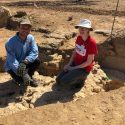UW-Madison study of class of ’57 becomes leading research on aging
During the last 50 years, participants in the Wisconsin Longitudinal Study have helped researchers explore the experience of careers, family life, family and education in America.
Now, the groundbreaking University of Wisconsin–Madison sociological study — which has involved more than 10,000 graduates of Wisconsin’s high school class of 1957, along with their siblings and spouses — will serve as the seminal study on aging and the effect of those life experiences.
With 77 million baby boomers poised to head into retirement in the next 20 years, the National Institute on Aging understands the value in the study’s findings and has funded the latest round of research.
“What we learn from the class of ’57 cohort is going to predict a lot about what’s going to happen to the similar population of the baby boomers when they come along,” says Carol Roan, assistant scientist for the Wisconsin Longitudinal Study.
While the study used to be primarily focused on work and education and the relationships between them, as the class is aging, the study is now focused more on physical health and memory.
For the first time in its 53 years, interviewers for the study are meeting participants in person to take some physical measurements that can’t be gauged over the phone: height, weight, vision, waist and hip circumference, mental cognition, grip strength and a chair rise.
Scientists have also been increasingly interested in researching how memory and thinking change across the life span and to what extent genes play a role in this change. Many study participants have donated a saliva sample, which has allowed researchers to study genetic markers for diseases like Alzheimer’s in relation to measures of memory and thinking throughout their lives.
Because the Wisconsin Longitudinal Study is a population-based sample and not a sample of families where there is a history of memory loss, and because it has multiple measures of memory at more than one point in time, study participants are uniquely suited to help researchers better understand memory loss, researchers say, with the hope it will lead to better treatment for future generations.
“A lot of the questions now are really trying to learn more about how their past experiences are influencing their current health and well being,” Roan says.
The study is itself undergoing a fundamental change, with Pamela Herd, a professor in the La Follette School of Public Affairs and the Department of Sociology, and Roan, joining the team of director and UW–Madison sociology professor Robert Hauser and senior scientist Taissa Hauser, who have led the study since the 1970s.
The study started at UW–Madison in 1957 as a way to survey the state’s high school seniors about their post-graduation plans. The research has expanded in recent years to include studies of siblings and spouses of members of the class of ’57.
Data about siblings is extra valuable because it gives researchers information about what the siblings have in common with each other and what might be a function of environment over genetics.
But over the years, what’s been most important is that the members of the class have been open to contact from researchers, with the study having an unprecedented response rate of as much as 90 percent.
For the current study, interviewers have met with more than 4,000 participants already, at a pace of about 500 a month.
Class of ’57 members are scattered around the country, although about 70 percent still live in Wisconsin.
Because of their willingness to be part of the study, the class of ’57 has turned the Wisconsin Idea on its head, giving back to the university and the state, Roan says, adding that the class has a feeling of ownership in the study because of the way it has documented their lives.
“It’s about them,” she says. “They have a sense of pride in what they’re doing and what they’ve accomplished by sharing their lives with us,” she says.
Their enthusiastic participation has produced research for which there is no comparison, Herd says.
“The main thing that makes the Wisconsin Longitudinal Study valuable is the fact we’ve been following them since 1957,” Herd says. “If you really want to understand people’s lives, you have to have information across their entire life, and that’s what we have.”



